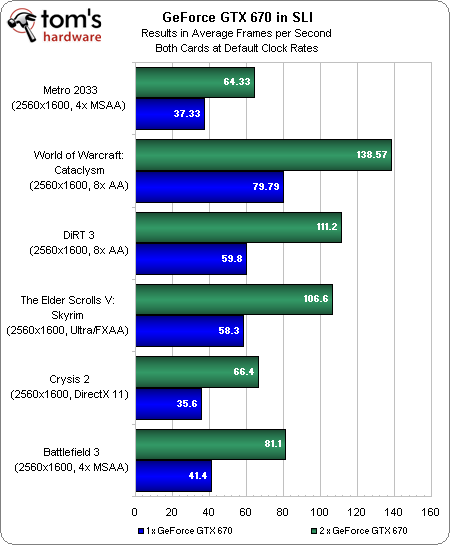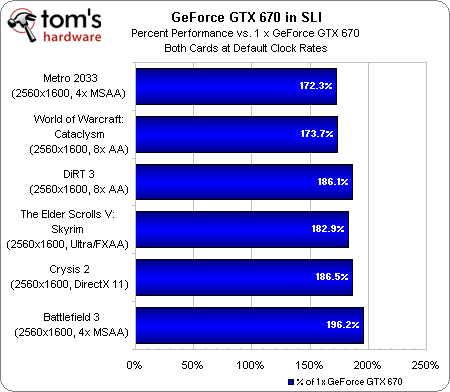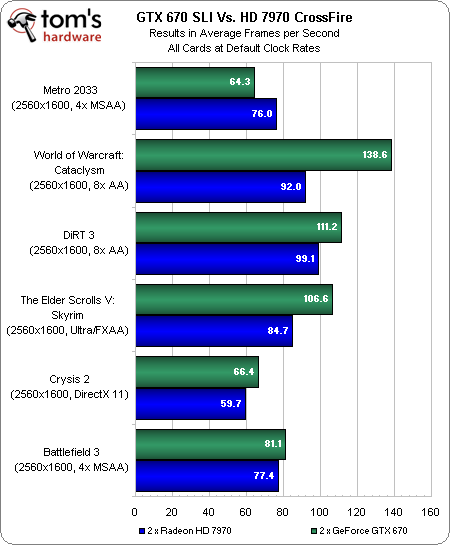GeForce GTX 670 2 GB Review: Is It Already Time To Forget GTX 680?
Not like it was ever really widely available anyway, right? The GeForce GTX 670 offers most of GK104's on-chip resources, doesn't give up much performance, and costs $100 less. Now, let's see if Nvidia can make enough of them to satisfy demand.
Two GeForce GTX 670s In SLI
As you start sliding down the price ladder, adding a second card right away or somewhere down the road becomes a more attractive (and more realistic) proposition. Paying $800 for a couple of GeForce GTX 670s is still a lot of money, but $400 now and as much or less in a few months doesn’t sound as bad.
How, then, do a pair of GeForce GTX 670s perform compared to just one?

At 2560x1600 with graphics details cranked up, a second GeForce GTX 670 can turn marginal playability into a smooth experience. If you’re only gaming at 1920x1080, there’s really not much reason to add a second board. But as you start exploring 30” screens or multi-monitor gaming, a configuration like this makes a lot more sense.

Dividing those numbers into each other, we see that the best-case is Battlefield 3, where a second GeForce GTX 670 nearly doubles performance. Metro 2033 and WoW are both worst-case scenarios in our suite, where the second board boosts frame rates by 72 or 73%.

And now, the title match. Two GeForce GTX 670s against a pair of Radeon HD 7970s.
Five times out of six, the 670s are faster. The sixth is Metro 2033, where two Radeon HD 7970s are about 18% faster. Even in World of Warcraft, though, where Nvidia’s cards are more than 50% faster, performance is high enough on both setups that the experience is fluid.
One thing to keep in mind, though: Radeon HD 7970s are scalable up to four cards (as are GeForce GTX 680s). Nvidia is limiting its GTX 670s to three-way SLI. I don’t see that as a problem, since the market for four-card configurations is diminutive.
Get Tom's Hardware's best news and in-depth reviews, straight to your inbox.
Update (5/11/2012): Reader jaquith noticed that EVGA's box art listed four-way SLI as a feature of the GeForce GTX 670. We went back to Nvidia for comment and received word back that the packaging would need to be changed. A short time later, a new message indicated that a future driver will, in fact, add four-way SLI support to the GeForce GTX 670s. Apparently, this is a matter of validation that Nvidia still needs to perform, not a technical issue with the hardware or software.
Current page: Two GeForce GTX 670s In SLI
Prev Page GeForce GTX 670 Versus GTX 680 And Radeon HD 7970 Next Page Are We Still Taking These Launches Seriously?-
tecmo34 Great Review Chris!!Reply
Though there isn't really a performance hit but it would be great to have seen the GTX 670 running at PCIe 3.0. -
master9716 OMFG no 5760x1080 benchmarks again?!! ima have to go to hardware.info or something wow!Reply -
gilgamex101 "Dude.......seriously!?........you sure?.......wait wait, what about image qual--.....no......looks fine.........awwww.......AWWWWWWW !@#$......!@#$.........!@#$ !^&* *&^%$#@!@.....and you !$%^*(......green peice of !@#$%............GREAT.......JUST BEAUTIFUL.....- AMD in response to 670 GTX reviewsReply -
rglaredo I hate Nvidia and their supply and demand game ...it is obvious that they are just holding off the cards to inflate the prices...I'm going with AMD ....because I'm tired of waiting ...I'm not going to wait anymore ..Reply -
sayantan Nice move nV , forcing AMD to drop their prices for entire lineup. A 7970 at $400 would be really awesome...Reply -
godfather666 The list of games is very unfair to AMD cards. Techpowerup's review, which featured a much longer list of games, had the Radeon HD 7970 faster than the GTX 670 at all resolutions 1080p and higher.Reply
Nvidia has had a big lead in Dirt 3 and WoW for a very long time. This skews the results.
The GTX 670 is a fantastic card, don't get me wrong. Just pointing out that it's being slightly overrated here.
